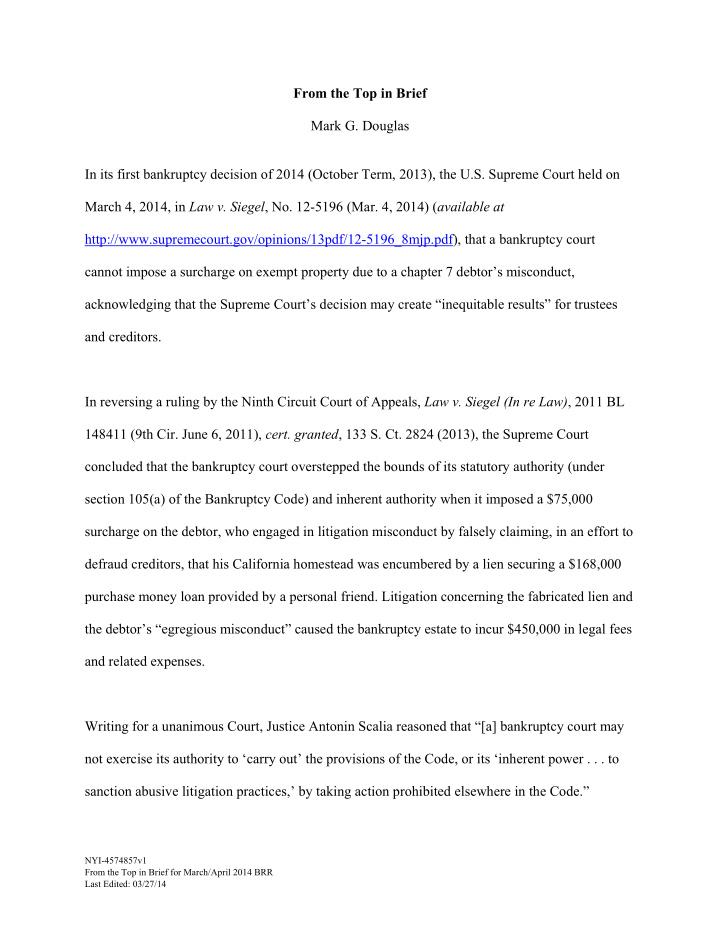



From the Top in Brief Mark G. Douglas In its first bankruptcy decision of 2014 (October Term, 2013), the U.S. Supreme Court held on March 4, 2014, in Law v. Siegel , No. 12-5196 (Mar. 4, 2014) ( available at http://www.supremecourt.gov/opinions/13pdf/12-5196_8mjp.pdf), that a bankruptcy court cannot impose a surcharge on exempt property due to a chapter 7 debtor’s misconduct, acknowledging that the Supreme Court’s decision may create “inequitable results” for trustees and creditors. In reversing a ruling by the Ninth Circuit Court of Appeals, Law v. Siegel (In re Law) , 2011 BL 148411 (9th Cir. June 6, 2011), cert. granted , 133 S. Ct. 2824 (2013), the Supreme Court concluded that the bankruptcy court overstepped the bounds of its statutory authority (under section 105(a) of the Bankruptcy Code) and inherent authority when it imposed a $75,000 surcharge on the debtor, who engaged in litigation misconduct by falsely claiming, in an effort to defraud creditors, that his California homestead was encumbered by a lien securing a $168,000 purchase money loan provided by a personal friend. Litigation concerning the fabricated lien and the debtor’s “egregious misconduct” caused the bankruptcy estate to incur $450,000 in legal fees and related expenses. Writing for a unanimous Court, Justice Antonin Scalia reasoned that “[a] bankruptcy court may not exercise its authority to ‘carry out’ the provisions of the Code, or its ‘inherent power . . . to sanction abusive litigation practices,’ by taking action prohibited elsewhere in the Code.” NYI-4574857v1 From the Top in Brief for March/April 2014 BRR Last Edited: 03/27/14
According to Justice Scalia, the bankruptcy court’s surcharge contravened section 522 of the Bankruptcy Code, which gave the debtor the right to use California’s “homestead exemption” to exempt $75,000 of equity in his home from the bankruptcy estate. Justice Scalia acknowledged that the Supreme Court’s ruling may cause bankruptcy trustees and creditors to shoulder greater costs in fighting allegedly fraudulent claims. However, he wrote, “it is not for courts to alter the balance struck by the statute.” Moreover, he explained, ample authority remains to address debtor misconduct, including denial of discharge under section 727(a); sanctions for bad-faith litigation conduct under Rule 9011 of the Federal Rules of Bankruptcy Procedure, section 105(a), or a bankruptcy court’s inherent powers; enforcement of monetary sanctions through the procedures set forth in section 727(b) for collecting money judgments; and possible prosecution for bankruptcy crimes under 18 U.S.C. § 152. On March 25, 2014, the Supreme Court ruled in U.S. v. Quality Stores, Inc. , No. 12-1408, 2014 BL 80719 (Mar. 25, 2014), available at http://www.supremecourt.gov/opinions/13pdf/12- 1408_6468.pdf, that severance payments made to employees who were involuntarily terminated prior to and during an agricultural retailer’s chapter 11 case pursuant to plans which did not tie payments to the receipt of state unemployment insurance are taxable under the Federal Insurance Contributions Act (“FICA”). Prior to filing for bankruptcy and continuing afterward pursuant to a court-approved bonus plan, Quality Stores, Inc. (“Quality”) paid more than $10 million in severance pay, for which it made NYI-4574857v1 From the Top in Brief for March/April 2014 BRR Last Edited: 03/27/14
the required contributions under FICA. Quality later sought a refund of the tax payments, claiming that the severance pay should be exempt from FICA taxes. After the Internal Revenue Service (“IRS”) failed to respond to the refund request, Quality asked the bankruptcy court to rule on the issue. The IRS argued that the severance pay met the definition of “wages” for FICA purposes. Quality countered that the payments were made after employment ended and therefore should not be considered wages for work. The bankruptcy court, a district court, and the Sixth Circuit Court of Appeals all ruled in Quality’s favor. See Quality Stores, Inc. v. United States (In re Quality Stores, Inc.) , 383 B.R. 67 (Bankr. W.D. Mich. 2008), aff’d , 424 B.R. 237 (W.D. Mich. 2010), aff’d , 693 F.3d 605 (6th Cir. 2012). Other circuits, however, have concluded that at least some severance payments do constitute wages subject to FICA tax. See CSX Corp. v. United States , 518 F.3d 1328 (D.C. Cir. 2008); University of Pittsburgh v. United States , 507 F.3d 165 (3d Cir. 2007); North Dakota State Univ. v. United States , 255 F.3d 599 (8th Cir. 2001). The Supreme Court reversed the Sixth Circuit’s ruling in Quality Stores . Writing for a unanimous court (with Justice Kagan taking no part in the consideration or decision), Justice Kennedy explained that: (i) “[a]s a matter of plain meaning,” severance payments fit the definition of “wages” under FICA because “[t]hey are a form of remuneration made only to employees in consideration for employment”; and (ii) the provisions of the Internal Revenue Code ( see 15 U.S.C. §§ 3401(a) and 3402(o)) governing income-tax withholding do not limit the meaning of “wages” for FICA purposes. NYI-4574857v1 From the Top in Brief for March/April 2014 BRR Last Edited: 03/27/14
The ruling may have a significant impact on the future implementation of severance-pay plans for companies undergoing restructuring in or outside bankruptcy. NYI-4574857v1 From the Top in Brief for March/April 2014 BRR Last Edited: 03/27/14
Recommend
More recommend